#best education providers in australia
Text
PSA : THE INDIGENOUS VOICE REFERENDUM 14th October 2023
The Yes Vote is literally just giving indigenous Australians A SEAT AT THE TABLE to give information and advice about issues and governmental decisions that affect them.
Indigenous information and advice for indigenous issues from indigenous Australians.
That's it . It's acknowledging their existence as the first peoples of Australia and recognising that they have valuable information to contribute about their cultures, the ways they live, what their most pressing needs are and the best ways in which to help, to enable governments to effectively help them.
The government already provides "help" each year, in an effort to close the gap on education access, healthcare access, and many other pressing needs - they are already using taxpayer money to do this but crucially, these efforts have not been successful because we are missing out on crucial information.
The Voice to Parliament gives the government access to invaluable information that enables it to create and better implement aid, education, healthcare , equal opportunity.
I have been very actively involved in many Reconciliaton efforts for the vast majority of my life -
At 16 I travelled to some of the indigenous rural communities in Australia, met elders and individuals no tourist has access to meet, learnt from them, and saw what was there.
I saw the attempts, the efforts to provide access to Western education, that the rest of the country has, to provide healthcare, housing etc.
They don't work
They are based on western ways of life, ideas of community and interaction.
It's not the same.
They don't work.
Fundamentally because even if well intentioned, your efforts to help can actually harm if you don't have access to crucial information about how indigenous communities live.
We need to accommodate our help, our efforts, our aid to the specific needs and ways of life, values and dynamics of the many indigenous communities, especially rural, that exist across Australia, so that they have access to the same human rights we all do.
The human right to healthcare and education that we all have- it's not accessible in the same ways for indigenous communities.
It's provided, but on western terms- with the western expectation that children will leave their families for 6 months at a time and travel extremely far away to attend school, for example.
This is so backwards and outdated even for western sensibilities, and an incredibly outdated mode of education that is unhealthy emotionally for any child, let alone vulnerable people who have to choose between a western run school and their culture, their families - literally being a part of their community, a present member.
There are better ways to provide access to education than this. Ways that don't disrupt their connection to community, land and culture.
And the best people to ask, to provide information that can properly inform us about these issues, and how best to navigate them, fix them, are the the indigenous Australians themselves- they are the experts.
So that our aid and help and efforts actually do - help. Actually work.
The funds are going there anyway. So we need to put it to use in effective ways.
What we have now doesn't work.
We can only make it better.
Please Vote YES for The Indigenous Voice to Parliament
It is the beginning of lasting, effective positive change for vulnerable communities, and for us all.
#VOICE TO PARLIAMENT#THE VOICE#AUSTRALIA#YES 23#YES23#AUSTRALIAN REFERENDUM#AUSTRALIAN REFERENDUM 2023#INDIGENOUS VOICE TO PARLIAMENT#AUSTRALIAN POLITICS#INDIGENOUS AUSTRALIANS#AUSPOL#REFERENDUM#YES#VOTE YES#Important#Pertinent#Please share#love#Vote#Voting
157 notes
·
View notes
Text
Calcinidae Bay Lot Tour: the Public Schools
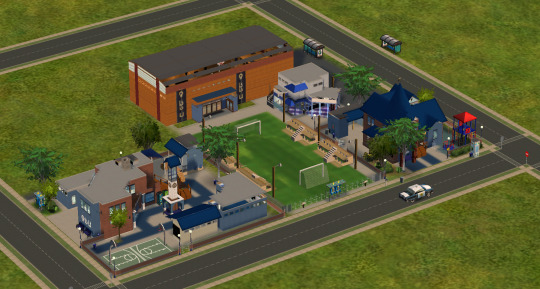
Let's take a closer look at a few of Calcinidae Bay's community lots - its public schooling! This screenshot is actually three lots, with two lots overlapped using the Lot Adjuster. On the left is the high school, on the right is the primary school, and between them is a shared gymnasium and a semi-public oval (sports field).

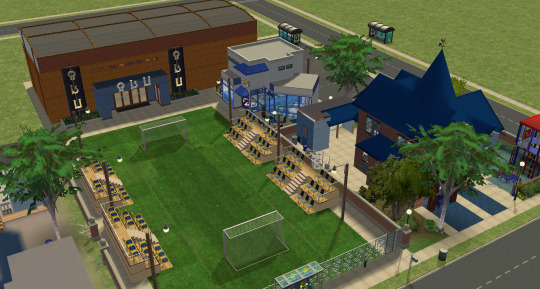
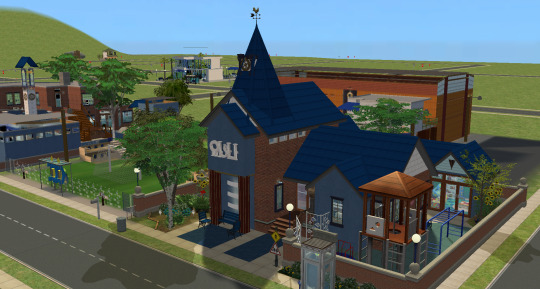
More pics & CC-free decorating ideas below!
As always, these lots are based on shell challenges. The high school and primary school are actually shells that were made for me by @hugelunatic as stocking stuffers back in 2022 (I didn't forget about them!)
The shell from the gym/oval lot is actually the smaller canteen building, with the gymnasium being auxiliary (because it had to be such a specific size/shape), and that shell is a 4T2 adaptation of LilSimsie's "Yeehaw" Shell Challenge that I grabbed off the gallery.
Starting with the high school:

If you peeked at the original shell, you'll see there was a two-storey 1x1 "column "room" in the middle of the lot, which made me think of a bell/clock tower and inspired me to use these shells for schools.
Normally when I adapt a TS4 shell challenge to TS2 I choose the placement & orientation on the lot, but because these lots were made natively in TS2 I decided to keep the lot size & distribution as they were. This gave me a lot of additional space around the main building that was perfect for adding extra amenities like a library.
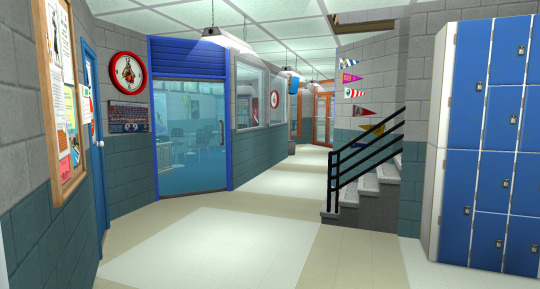

The ground floor of the high school has an administration area, lockers, mixed bathroom, sick bay, staff room, and two general-use classrooms that can each fit six students.
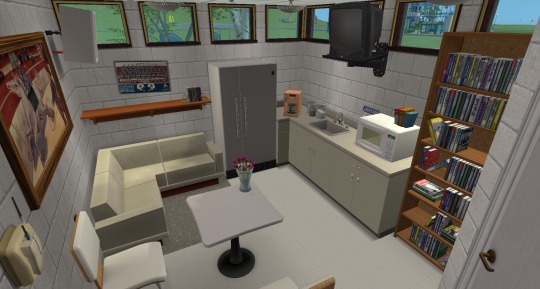

The teacher's lounge/staff room, and a small display/awards case. I needed something to do with that little triangular pocket, and now it's one of my favourite features. :)
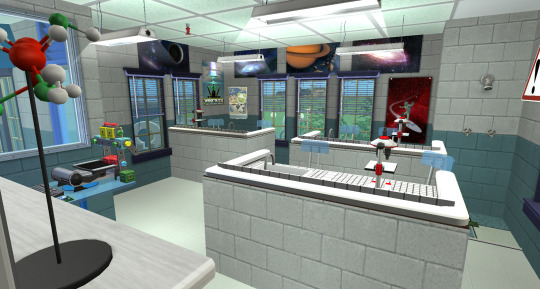

Upstairs is two specialised classrooms - a moderate science lab and an arts room. I would have liked at least a home ec classroom as well, but I guess that'll be reserved for the eventual private school.
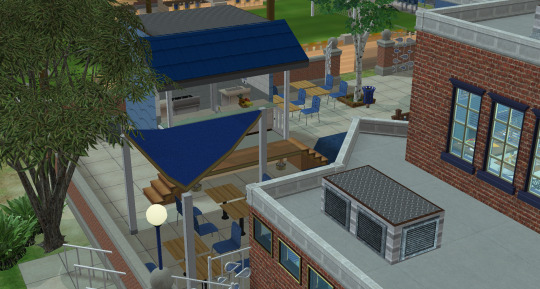
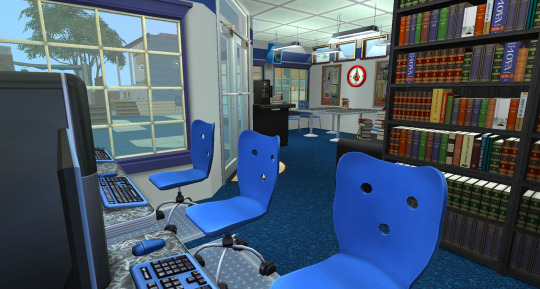
The canteen (cafeteria) is a separate demountable building with outdoor seating, some of it under a shade cloth. The library is also a separate building with a small computer bay and a group study area.
Moving on to the primary school, a much older and smaller building with some minor remodeling so the two schools look cohesive:

The inspiration for my gameplay/lots is a mish-mash of different cultural influences, but I play my schools like the standard Australian system; kids start in reception (about age 5) and attend primary school all the way through to year 6 or 7, then go to high school from year 6/7 through to year 12. Separate middle schools are much less common, and this matches with how the game itself handles kid vs. teen education.


I design my lots kind of "representationally", to get the best balance between realism and playability. While I enjoy including some details that don't provide actual gameplay, I don't want to build enormous, cumbersome lots just to achieve a 1:1 scale when my Sims will never actually need that much space. Plus, most shell challenges tend to be smaller, which I like. Hence why this school has only two classrooms, one for junior primary and a more structured classroom for upper primary.
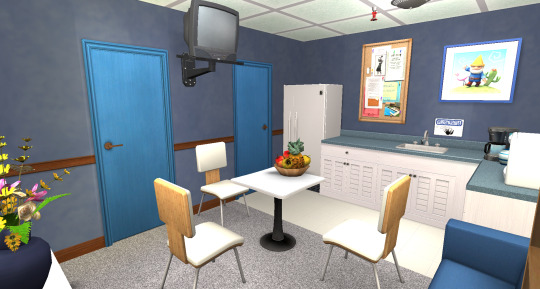
There is a small admin area downstairs. Upstairs is the sick bay and a modest teacher's lounge/staff room.

The primary school doesn't have its own library, but it does have a small separate building that we in Australia would call OSHC - Out of School Hours Care. It's a service parents can book to drop their children off before school starts, or arrange for them to attend after school finishes until they can pick them up. They provide snacks and some edu-tainment activities. Lots of kids also attend OSHC over school holidays.

The primary school canteen/cafeteria is also a separate building. Both school canteens use the University cafeteria stove, so with the right mod students will be able to grab food there. In addition to an outdoor eating area and a small playground, there is a little produce patch between the two buildings where students are taught about horticulture.
And finally, the lot that joins the two schools, the shared gymnasium and Calcinidae Oval.


The canteen/cafeteria itself would generally not be open during school hours. Instead, the school and/or local council would operate it for profit or hire it out to a third party when the oval was being used for local sports teams and other events on weekends, holidays, and after school hours. Right now it's set up for just such a soccer match.


The inside of the "tuckshop". There is a bathroom on the bottom floor accessible from the outside of the building, while the top floor has two changing rooms for students or local teams.


The gymnasium also serves as an assembly hall for students of both schools. I think the teachers would either have a collapsible stage at the far end of the court, or just stand up in the commentator's booth to give the announcements.
Underneath the commentator's booth is the equipment storage shed where many a teen couple has probably sneaked off to make out.
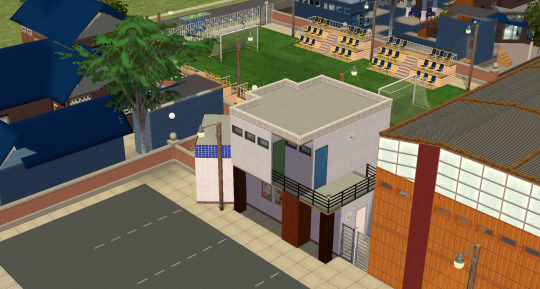
The back view of the tuckshop and the carpark shows how this lot overlaps with the primary school. The existing primary school is blocked from Sims walking through it by a combination of real fences and this hidden CC-free invisible fence.
And that's it for this tour! I'm pretty happy with how these lots look, how I utilised the shells, and how they all fit together in the neighbourhood. I want to have more lots overlapping and slotting together like this to give Calcinidae Bay a more seamless, open feel, like the hood really is connected.
I'll finish this post with some floorplans - if you read all this you're a champ, I hope it gave you some ideas for your own game, and I'd love to know what you think!


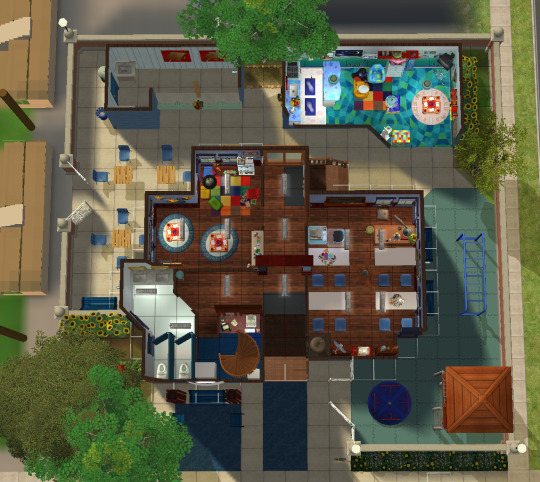

34 notes
·
View notes
Note
as far as i'm aware from reading US news (ny times) most of the smoke on the US east coast is from the canadian fires. also, the fires in canada are a lot lot lot worse than looks on the image you can see - hundreds of fires burning all across canada.
as a californian myself, i've also been kind of annoyed seeing all the news about like 'unprecedented smoke in nyc' like seriously? this isn't unprecedented, just for them specifically. I understand that seeing the orange skies was crazy but like...it's not new...I literally saw that myself during the fires of 2020 in Calif. i've had friends and family had to evacuate from nearby fires, i had to wear an n95 during the summer before covid because being outside in that air quality made me feel sick. my brother had school and sports cancelled because it was too dangerous to be outside breathing the air.
calif, oregon, washington, british columbia and all of the western US and canada (maybe mexico too, I don't know about impact of smoke/fires in central or latin america) have been dealing with this for years. australia and nz have been dealing with this too for years.
I'm sorry...I kind of just wanted to complain a bit...it was a bit jarring seeing all those headlines about it being new when it's really not, it's just only new for the US east coast which has the biggest & loudest mouthpiece coming from america.
i'd also love to see some resources about the fires in canada if anyone has sent you any. i know for california, Cal Fire (fire.ca . gov) has info on calif. since there was a lot of rain this year (i've never seen so much rain in my life) i'm hoping fire season won't be too bad but we never know...
hi anon!
it's okay to vent about it. i understand that for those who have dealt with or are currently dealing with large wildfires would be annoyed by those who are not experiencing it as they are. still, i don't think it's right to blame those people without educating them a bit on it first.
honestly even when it comes to the east coast smoke most news talk specifically about nyc than the other places dealing with the same thing. picky news coverage can be frustrating to say the least.
and you're certainly right about it being new to us but not everyone else. the east coast is generally pretty wet with hurricanes in summer (which hurricane season officially started around a week ago, which i'm curious if it'll be affected at all since the smoke is also going east into the atlantic and wildfire smoke throws off marine ecosystems and cyclones are worse when the water is warmer) and snow storms during winter. i think no matter where you are, people will react extremely if something out of the ordinary happens. personally i can't even imagine it since even when i lived on the west coast, it was near seattle and mostly wet.
thank you for providing some info on california! nobody else has sent anything yet, but i'll definitely post if they do! :)
my screenshot was from fire.airnow.gov and from zooming in more i get a slightly better picture of where the fires are but the low accuracy is likely because the site's focus is only the us. nasa is usually quite good in capturing this things in the states, so i checked the canadian space agency to see if they had better images of the fires. while i didn’t find any recent satellite images (best i found was a video from a month ago), i was directed to the Canadian Interagency Forest Fire Centre (CIFFC) which has an updated interactive map on the homepage. This site alao has links to individual centers in each province.
#canadian wildfires#canada#canadian smoke#wildfire#wildfires#climate change#weather#meteorology#academia#studyblr#north america#raine answers
18 notes
·
View notes
Photo

On November 25th 1835 the steel magnate and philanthropist, Andrew Carnegie, was born in Dunfermline.
“To try to make the world in some way better than you found it is to have a noble motive in life.” - Andrew Carnegie
Today I thought we’d look into things we might not know about Andrew Carnegie
So how rich was he really? Well in 2015, the Carnegie Corporation estimated that at his peak wealth, Carnegie was worth $309 billion (accounting for inflation). For comparison, in 2022, Elon Musk is worth about $219 billion, Jeff Bezos is worth roughly $171 billion and Bill Gates comes in at $129 billion.
“To try to make the world in some way better than you found it is to have a noble motive in life.” - Andrew Carnegie
Andrew Carnegie's philanthropic career began around 1870 in his native Dunfermline and ultimately extending throughout the English-speaking world, including the United States, Australia, and New Zealand.
In 1887, Carnegie married Louise Whitfield of New York City. She supported his philanthropy, and signed a prenuptial marriage agreement stating Carnegie’s intention of giving away virtually his entire fortune during his lifetime. Two years later he wrote The Gospel of Wealth, which boldly articulated his view of the rich as trustees of their wealth who should live without extravagance, provide moderately for their families, and use their riches to promote the welfare and happiness of others. This statement of his philosophy was read all over the world, and Carnegie's intentions were widely praised.
“The man who dies thus rich dies disgraced.” - Andrew Carnegie
In 1889, Carnegie published The Gospel of Wealth, publicly extolling his beliefs that personal wealth should be distributed for community benefit once your family’s needs were taken care of.
“The problem of our age is the proper administration of wealth, so that the ties of brotherhood may still bind together the rich and poor in harmonious relationship,” - Andrew Carnegie
Want to hear the man himself reading from his Gospel of Wealth check the link below
https://www.youtube.com/watch?v=7-kyH2cq0b8
In 1911 Andrew Carnegie established Carnegie Corporation of New York, which he dedicated to the “advancement and diffusion of knowledge and understanding.” It was the last philanthropic institution founded by Carnegie and was dedicated to the principles of “scientific philanthropy,” investing in the long-term progress of our society. Carnegie himself was the first president of the Corporation, which he endowed in perpetuity with his remaining fortune — $135 million — to be used principally to promote education and international peace. While his primary aim was to benefit the people of the United States, Carnegie later determined to use a portion of the funds for members of the British Overseas Commonwealth. For the Trustees of the Corporation, he chose his longtime friends and associates, giving them permission to adapt its programs to the times. “Conditions upon the earth inevitably change,” he wrote in the Deed of Gift, “hence no wise man will bind Trustees forever to certain paths, causes or institutions…. They shall best conform to my wishes by using their own judgment.”
By the time of his death, Andrew Carnegie, despite his best efforts, had not been able to give away his entire fortune. He had distributed $350 million, but had $30 million left, which went into the Corporation’s endowment. Toward the end of his life, Carnegie, a pacifist, had a single goal: achieving world peace. He believed in the power of international laws and trusted that future conflicts could be averted through mediation. He supported the founding of the Peace Palace in The Hague in 1903, gave $10 million to found the Carnegie Endowment for International Peace in 1910 to “hasten the abolition of international war,” and worked ceaselessly for the cause until the outbreak of World War I. He died, still brokenhearted about the failure of his efforts, in August 1919, two months after the signing of the Treaty of Versailles.
Andrew Carnegie helped give the world Sesame Street -Yes really!
The Carnegie Corporation provided the American television writer and producer Joan Ganz Cooney with the funds to develop Sesame Street and the Children’s Television Workshop. According to Sherrie Westin, executive vice president of global impact and philanthropy at the Sesame Workshop, “Sesame Street literally would not be here were it not for the bold vision and audacious philanthropy of the Carnegie Corporation.”
The iconic saguaro cactus is named after him, the plant, which is found only in the Sonoran Desert in Arizona and Mexico, can live as long as 200 years and grow to be 45 feet tall. Its scientific name, Carnegiea gigantea, is a nod to Carnegie’s philanthropic contribution to botany: The Carnegie Institution, founded in 1902, helped establish the Desert Botanical Laboratory in Tucson in 1903.
One of Carnegie's major philanthropic efforts included donating 7600 of the instruments to churches across the United States. He also oversaw the installation of the 8600-pipe organ at Carnegie Music Hall in Pittsburgh in 1895 and had pipe organs in his homes in New York and Scotland.
In keeping with his wealth philosophy, Carnegie left his wife Louise a small amount of money, as well as their properties in Manhattan and Scotland, when he died. His only child, a daughter named Margaret, received nothing but a small trust. She eventually had to sell the family townhome because it was too expensive to maintain. But that was it—the rest of his immense wealth went to his charitable causes and endowments.
You might think that that would cause some resentment on the part of his heirs, but they apparently all agreed to the arrangement well before Carnegie passed away.
63 notes
·
View notes
Text
Daughter-in-law From Hell by Ramesh Thakur
"But what if the interview has damaged the prospects of this happening? Now that would be karma."
The cruel mother-in-law is a familiar and popular trope all over the world, not far behind the stepmother as a proxy for the evil witch. Curiously, there’s no alternative, counter-balancing trope of a cynical, calculating and manipulative daughter-in-law who rents asunder the existing close bonds in a family.
I was born in India after independence and grew up in a free republic. Even while absorbing many of the idioms and iconic stories from our British political-education legacy, we were also socialised into the anti-British strains of the independence struggle and viewed many familiar historical milestones through completely different lens. This came together in a popular explanation for why the sun never set on the British Empire: because even God would not trust an Englishman in the dark. In the second half of the last century, that ambivalence was transferred to the Americans and best captured in the placard being waved by the anti-Vietnam War protestor in the streets of Calcutta during my university days there: ‘Yankee! Go home – and take me with you’.
On the other hand, I left Calcutta (since renamed Kolkata) for Canada and in the course of my wanderings have lived and worked, among other places, in New Zealand and Australia and collected citizenships in all three. This means I have sworn the oath of loyalty to Her Majesty three times in her capacity as the Queen of Canada, New Zealand and Australia. I feel impelled accordingly to defend her and ‘the Firm’ against the attacks from Meghan Markle in the infamous interview with Oprah Winfrey. Full disclosure: I have not watched the interview, not even a minute of it, and have no intention of doing so. My comments are based on accounts of it in print.
To start with, the Queen’s life is a story of duty to country and the multiracial Commonwealth carried out with unfailing grace, dignity and decorum. Between the Duchesses of Cambridge and Sussex, who does and does not fit in with this lifestyle? To ask the question is to answer it. Markle gives the impression she had a glamourised vision of what marrying into the royal family would be like. The measure of self-discipline and onerous restrictions on independence and personal freedoms proved too suffocating, which is easy enough to understand. The press can indeed behave with no sense of moral compass, violate peoples’ privacy – who can forget the phone-hacking scandals – and turn viciously on someone. But the search for privacy taking her to a tell-all interview with the Queen of TV that turned out to be a self-indulgent settling of scores? A couple that has complained loudly about press intrusions was happy to wash the family laundry in public for millions of viewers. Their remarks and ‘revelations’ were calculated to inflict the maximum damage on her husband’s family. No matter what the provocation, that is unforgiveable. She has a long history of manipulating the media to boost her celebrity status. She can make truly awful accusations against her in-laws. No proof required. The warmth with which she was welcomed by the family – remember the touching scene when Prince Charles walked her down the wedding aisle owing to the absence of her father? – as well as press and people, makes the charge of racism implausible.
Why say things without substantiation that will make the estrangement from his family irreparable? Because she names no names, provides no context and fails to specify exactly what was said, the entire royal family is smeared and that too on the flimsiest of reasoning. This is not courageous but cowardly. Someone wondered about the skin colour of the child while he was still in the womb. Well cry me a river in a $20 million mansion in Santa Barbara. As an inter-racial family that is increasingly common in the UK, Australia, Canada, New Zealand and the US, we wondered the same about our children and speculated on it on multiple occasions. And repeated the experience with the next generation. As soon as this article is done, I’m off to enrol myself in cultural re-education class to exorcise this deep-seated unconscious racism. So, sorry, but until and unless we are provided with some context and specificity about who made the remark, that sounds like interested curiosity rather than malicious racism.
Along with racism, mental health and thoughts (ideation, in the current jargon) of suicide have been weaponised by wannabe victims in the proliferating grievance culture. I’m afraid for once my instincts are similar to those of Piers Morgan. President Joe Biden has praised Markle’s courage for talking openly about feeling suicidal. But the charge that the pleas for help of a five-month pregnant Duchess of Sussex expressing suicidal thoughts would be dismissed with the comment that it ‘wouldn’t be good for the institution’ is, on the face of it, implausible. Once again, we need more specificity and context. On its own, this simply doesn’t ring true. Who was that callous palace official? What stopped the couple from seeking treatment directly from the several mental health charities with which they are connected?
In the interview Markle claimed her son not being a prince ‘would be different from protocol’. Displaying the racial prism through which she views everything, Markle said Archie is ‘the first member of colour in this family not being titled in the same way that other grandchildren would be’. This is factually wrong as well as incendiary. Someone so conscious of titles should know that her son cannot be called a prince at present. Under existing rules going back to 1917, the titles of prince and princess are limited to children of the monarch, children of the monarch’s sons and the eldest living son of the eldest son of the Prince of Wales. In other words, Archie cannot be prince with the Queen as monarch but will be due the title if and when Prince Charles becomes King.
"But what if the interview has damaged the prospects of this happening? Now that would be karma."
94 notes
·
View notes
Text
Dermal Filler Introductory and Advanced skills
If you are passionate about learning modern cosmetic practices and want to be an efficient aesthetician, our basic to advanced-level dermal filler course can be your ultimate destination. Let’s explore.
Dermal Filler Introductory and Advanced skills
This dermal filler training provides a blended learning style with online theory and a practical day. Most importantly, our course covers introductory to advanced dermal filler training with minimal students to ensure more one-on-one supervision, learning support and hands-on experience. Besides, our dermal filler course for beginners is specially designed to train you from key foundation concepts that go beyond dermal fillers. Also, this dermal filler training course is perfect for inspiring professionals seeking a well-rounded academic experience.
KEY FEATURES OF OUR COURSE
Theoretical online class
Application Learning
One-day practical class( Basic to Advanced)
Capped to five students
Problem-solving and risk management training
Professional Code of Conduct
PRACTICAL DATES(VIC)
15/01/2023
What Does Dermal Filler Introductory And Advanced Skills Offer?
Key learning factors ranging from introductory to advanced dermal filler training are:
1. Basic Knowledge Of Facial Anatomy
First, our dermal filler training introduces you to facial anatomy and vascular structures. Learning contents are developed to provide knowledge about facial fat pads, veins, arteries, and nerves in that region so that the practitioner is able to mitigate complications while injecting dermal fillers accurately.
2. Types of Dermal Fillers And Applications
Depending on the facial area and specific concerns, choice of dermal fillers and their application differ. We cover their range and the most common, Hyaluronic acid fillers.
Course curriculum includes lessons on their features and unique properties of dermal fillers. As a result of studying this cosmetic injector course you get the best outcome for your clients by choosing the right filler.
3. Injection Techniques and Depth
In this cosmetic injecting course,we cover the application and techniques which are crucial parts of cosmetic injections. Here, we expand on all different types of techniques for each third of the face and the required depth and angle. This theoretical knowledge coupled with practical skills provide a great learning curve for our students.
4. Risk Assessment and Complication Management
This is the most delicate part of any clinical treatments to ensure safety. Our institution teaches students how to recognise risks and complications and how to effectively manage it.
5. Advanced Approaches and Combination Therapy
We encourage our learners to understand clients’ realistic goals and recommend other treatments that may be better suited prior to devising a treatment plan.
6. Ethics and AHPRA Regulations
We also cover ethics and latest AHPRA regulations to ensure your currency.
7. Self Dependence Support
After being qualified, we motivate our students to start their journey and provide guidance. As a cosmetic nursing course in Melbourne, we ensure to establish our students with support, advice and engagement.
8. Evidence- Based Learning
We believe in science, modern technology and documents at every step. We are committed to teaching evidence-based learning approaches all the time and always update our course which you have a lifetime access to.
Why Are We The Best For Dermal Filler Training Courses In Melbourne?
Nowadays, there are so many online and offline programmes that provide aesthetic courses. Among so many injectable institutes in Australia, what are the reasons behind choosing us as your trusted dermal filler course? Here is your answer below.
Efficient Mentorship
First, we ensure well-educated and highly experienced clinicians run our courses so that the students can get in touch with real-life experience and evidence-based curriculum. Besides, our courses offer the opportunity for knowledge sharing that contributes highly to learning purposes.
Both Theoretical And Practical Curriculum
To be efficient in a dermal filler course, a student requires theoretical and practical learnings that we provide with equal value. Our core anatomy chapters enrich our courses followed by injecting techniques and post-filler management. So, it’s the perfect combination of knowledge development and proficiency.
Long-Term Support
After completing this course, our students can contact us for support, including business set-up. Our advice and new research-based learnings will help you establish your careers.
Professional Certification
We offer cosmetic nursing courses in Melbourne and professional certificates that will contribute to enlightening our student’s careers and boosting their confidence with knowledge. Your certificates will be recognised across Australia given our current endorsements from well known organisations.
Conclusion
In the present world, a Dermal filler course can be a valuable clinical skill that contributes to leveling up your career. So, if you dream of being an efficient aesthetician, this is the right time to educate yourself. As an established dermal filler course provider, we are always here with support and guidance.
Enquire now!
2 notes
·
View notes
Text
Affordable Accommodation Options in Australia for Students
Australia is a dream destination for many international students seeking quality education and vibrant cultural experiences. However, the cost of living, including accommodation, can be a concern for students on a tight budget. Fortunately, there are various affordable accommodation options across the country to suit students' needs without breaking the bank. Here are some tips and suggestions for finding cheap accommodation in Australia for students:
1. University Accommodation: Many universities in Australia offer on-campus accommodation options that are specifically tailored to students' needs and budgets. These accommodations often come with the convenience of being close to campus facilities and services. While prices may vary depending on the university and location, on-campus accommodation is generally a cost-effective option compared to private rentals.
2. Shared Accommodation: Sharing a house or apartment with other students is a popular choice among international students in Australia. This option allows students to split the rent and other living expenses, making it more affordable than living alone. Websites and social media groups dedicated to finding roommates or shared accommodation can be valuable resources for students looking to team up with others.
3. Homestays: Homestays offer students the opportunity to live with a local family while studying in Australia. This option not only provides affordable accommodation but also allows students to immerse themselves in the Australian culture and lifestyle. Homestays typically include meals and other amenities, making them a convenient and budget-friendly choice for international students.
4. Student Housing Providers: Several student housing providers operate across major cities in Australia, offering purpose-built accommodation for students. These providers often offer furnished apartments or shared rooms with inclusive utilities and amenities such as Wi-Fi, laundry facilities, and communal areas. While prices may vary depending on the location and facilities offered, student housing providers generally offer competitive rates tailored to students' budgets.
5. Budget Accommodation Options: For students looking for temporary or short-term accommodation, budget-friendly options such as hostels, guesthouses, and backpacker accommodations can be viable choices. While these accommodations may not offer the same level of privacy as other options, they are often the cheapest available and provide a great opportunity to meet fellow travelers and students from around the world.
6. Online Platforms: Utilizing online platforms and websites dedicated to rental listings can help students find affordable accommodation options in Australia. Websites like Gumtree, Flatmates, and Student are popular among students for finding rental listings, shared accommodation, and student-specific housing options.
7. Government Assistance: Some state governments in Australia offer financial assistance or subsidies to eligible students to help cover accommodation expenses. Students should explore available options and eligibility criteria through government websites or student support services offered by their educational institutions.
8. Early Planning: Planning ahead and starting the accommodation search well in advance can give students more options and better opportunities to secure affordable accommodation. As demand for student accommodation in Australia can be high, especially during peak periods, early planning is key to finding the best deals.
In conclusion, while Australia offers a high standard of living and quality education, finding affordable accommodation is possible for students through various options such as university accommodation, shared living arrangements, homestays, student housing providers, budget accommodations, online platforms, and government assistance programs. By exploring these options and planning ahead, students can enjoy their time studying in Australia without compromising their budget.
2 notes
·
View notes
Text
Benefits of Paid Education in Finland
Unilife abroad career solution

Benefits of Paid Education in Finland
A World-Class Education System
With one of best performing education systems in the world, it's no wonder over 14,000 international students have already chosen Finland for study abroad.
Finland continues to eclipse the United States, the United Kingdom, Australia, and New Zealand in math, science and reading scores, and as of 2019, Finnish universities were ranked among the top 3 globally.
Starting from early childhood, Finnish schools aim to prepare students for the real world, and give them the tools to live a meaningful life. Students are taught through a multi-disciplinary approach that combines self-study, problem-solving and self-development, which ensures a well-rounded learning experience from preschool through to university.
Student living costs in Finland
Average living costs in Finnish cities
In Finland, you will need between 700 – 900 EUR/month, depending on the area in which you will live. Helsinki is the most expensive city, while Laaperanta, Pori and Tampere are known as the most affordable student cities.
Equality and Freedom
Equality and freedom are cornerstones of the Finnish education system. In Finland, all students have equal opportunities to receive a high-quality education, and thanks to the flat hierarchy of Finnish universities, students are usually on a first-name basis with their professors.
Academic freedom is also a core value in Finnish universities. Unlike the United States or the United Kingdom, students in Finland have the freedom to decide which modules they'd like to study, ensuring that each student graduates with a diverse body of skills and knowledge.
Job Opportunities for Students
Good news for career-minded students — most Finnish universities provide career services for international students. They're available to lend a hand during your job search, whether you're looking for a student job, or a full-time position for after you graduate.
In Finland, it's not uncommon to have a part-time job alongside your studies — according to Statistics Finland, 55 percent of university students reported having an employment contract while studying.
If you're interested in working part time during your term abroad, your student visa will allow you to work for up to 30 hours per week. Which leads us to our seventh and final reason why you should study abroad in Finland..
Excellent Education System
Finland is renowned for its exceptional education system, consistently ranking among the top countries in global education rankings.
The Finnish education system focuses on holistic learning, encouraging critical thinking, problem-solving, and creativity.
Finnish universities offer a wide range of programs taught in English, ensuring international students have ample opportunities to pursue their desired fields and study in Finland.
Safe and Inclusive Environment
Finland is known for its safety and inclusivity, making it an ideal destination for international students. The society promotes equality, tolerance, and respect for diversity. Students can expect a warm and welcoming atmosphere where they can freely express their ideas, explore their interests, and engage in open discussions.
UniLife Abroad Services
Guides in choosing the right University or College.
Help to select the right study programs based on the candidate’s academic profile and career interest.
Help students with admission to the College or University as per their decisions.
Help to prepare the complete application for Student Visas.
Contact us : 8428440444 , 8428999090 , 8608777070
Mail ID : [email protected] , [email protected]
3 notes
·
View notes
Text
"Navigating the Cloud: Choosing the Best AZ-900 Training in Australia"
Introduction :
AZ900 certification will expand your career in today’s highly competitive business market, especially in cloud computing. Because it provides a strong base for cloud services and Microsoft Azure services, the Microsoft Azure basics AZ-900 certification is in high demand.
This will definitely help in choosing an Australian training program, making sure that we get the guidance and support we need to pass the process.
Understanding the "AZ900 Certification":
Those who wish to prove that they comprehend cloud ideas, core Azure services, Azure pricing, SLA, and lifecycle are intended to take the AZ-900 certification. This certification offers a strong basis for additional education and professional progression within the Azure ecosystem, and it also acts as a bridge to other, more specialized Azure credentials.

Why AZ-900 Certification Is Important
Validation of Azure Fundamentals:
Earning the AZ-900 certification validates your expertise in Azure services and core cloud principles, making you a valuable asset to any enterprise that uses Azure
Career advancement:
Getting licensed with AZ-900 allows you to consciousness on learning about cloud technology. This can result in new task opportunities and assist you pass ahead on your profession. Employers see AZ-900 certification as a signal of your capabilities and readiness to work with Azure technology, making you a desirable candidate for jobs.
Selecting Australia's Top AZ-900 Training Program:
When choosing an AZ-900 training course, it is important to consider several factors to ensure you receive the best instruction and support to match your learning needs:
Accreditation: Look for trainers who are accredited by Microsoft and have a history of excellent training courses.
Course topics: Ensure that the syllabus fully addresses each topic included in the AZ-900 exam objectives by observation.
Instructor Expertise: Make sure to check the qualifications and experience of the instructors who are teaching the course. This ensures they have the necessary skills and knowledge to teach the subject effectively.
Delivery Format: Consider how you prefer to learn and choose a course that offers different ways of learning. This could include live virtual sessions, online self-paced learning, or in-person classes.
Essential Components of the Top AZ-900 Training Program:
Broad Curriculum: The top AZ-900 training program will thoroughly cover every exam goal and give you a strong foundation in Azure principles.
Practical Labs: Engaging laboratories and tasks enable you to utilize theoretical understanding in practical situations, strengthening your education and enhancing your abilities.
Proficiency in Teaching: Throughout the course, knowledgeable instructors with a background in the business offer insightful commentary and practical advice, facilitating your understanding of challenging ideas.
Choice of Flexible Learning Options: Choose a training program that gives you the freedom to practice whenever it is most convenient for you.
Exam preparation: To help you feel confident and well prepared on exam day, we’ve armed you with effective resources, including practice tests and exam tips.

Advantages of Gaining AZ-900 Certification
Professional Prospects:
Holding the AZ-900 certification gives you access to various levels of cloud computing including Azure Developer, Cloud Administrator and Cloud Solution Architect
Potential Salary:
Due to the increased value and demand of their talents in the labor market, certified professionals frequently command higher pay than their non-certified counterparts.
Professional Development:
By showcasing your dedication to ongoing observe and certification, you undertaking to capability employers which you are a lifelong learner.
Opportunities for Networking:
becoming a Certified Azure Professional provides access to many resources and networking opportunities for professional development.
In conclusion,
For anyone looking to start or buy an existing cloud computing company, it’s worth the investment to get AZ-900 certified. You can choose a top AZ-900 training course in Australia and be confident of receiving the great advice and support you need to pass your certification program.

FAQs
Questions Frequently Asked About Our Training Services:
What aspects of cloud computing do you teach?
The definition, traits, deployment patterns, and service models of cloud computing are among the core ideas and concepts that we instruct students in.
Which advantages of utilizing cloud services are included in your training, and how can one obtain them?
Absolutely, throughout our training sessions, we go over the many advantages of employing cloud services, including scalability, cost-effectiveness, flexibility, and improved security.
Could you provide more details on the kinds of cloud services you instruct?
Sure, please respond.We cover the abilities and usage problems of diverse cloud services, including infrastructure as a provider (IaaS), platform as a provider (PaaS), and software as a carrier (SaaS).
Which fundamental Azure architectural elements are covered in your training?
In order to give students a thorough grasp of Azure architecture, our course covers the fundamental architectural elements of Azure, such as regions, availability zones, resource groups, and Azure subscriptions.
Do you offer instruction on networking and computing services offered by Azure?
Yes, we provide thorough training on Azure networking services including Azure VPN Gateway, Azure Load Balancer, and Virtual Network (VNet), as well as Azure compute services like virtual machines, Azure App Service, and Azure Kubernetes Service (AKS).
How about the storage services offered by Azure? Do you cover these in your training?
In response, yes. We cover each element of Azure garage offerings, which includes Azure Blob Storage, Azure Files, Azure Queue Storage, and Azure Table Storage, in detail during our session.
In your training, how do you cover Azure identity, access, and security topics?
To make certain a sturdy emphasis on security quality practices, we provide in-depth training on Azure identification and get admission to management. Topics protected include Azure Active Directory (AAD), role-based totally get right of entry to manipulate (RBAC), Multi-Factor Authentication (MFA), and Azure Security Center.
Could you elaborate on how your training covers cost management in Azure?
Sure, possibly respond. In order to assist businesses optimize their return on investment while reducing expenses, we train efficient cost management strategies in Azure, such as Azure Cost Management+ Billing, budgeting, resource tagging, and optimization techniques.
Which Azure governance and compliance features and tools are addressed in your training?
In order to make certain compliance with regulatory requirements, our training covers a whole lot of Azure governance and compliance abilities and technology, together with Azure Policy, Azure Blueprints, Azure Security Center, and compliance certifications like GDPR and HIPAA.
Do you offer instructions on the tools and functionalities used to deploy and manage Azure resources?
In-depth training on Azure useful resource management and deployment abilities and tools, which includes Azure Resource Manager (ARM), Azure PowerShell, Azure CLI, Azure DevOps, and Infrastructure as Code (IaC) standards, is to be had upon request.
In your training, which Azure monitoring tools are covered and in what way are they addressed?
In order to offer insights into the general performance, availability, and security of Azure assets, we address a number of Azure tracking gear, together with Azure Monitor, Azure Log Analytics, Azure Application Insights, and Azure Security Center.
2 notes
·
View notes
Text
Brewing Excellence Among the Best Coffee Roasters in Melbourne
In the bustling and coffee-loving city of Melbourne, the pursuit of the perfect cup is a journey embedded in the cultural fabric. As coffee enthusiasts embark on this quest, Gigante Techniflavour emerges as a distinguished player among the Best Coffee Roasters Melbourne. This blog explores the artistry and commitment to excellence that defines Gigante Techniflavour, positioning it as a beacon of exceptional coffee roasting in the heart of Australia's coffee capital.
Crafting the Perfect Cup: The Gigante Techniflavour Approach
Single-Origin Perfection:
Gigante Techniflavour takes pride in sourcing only the finest single-origin coffee beans from across the globe. Each batch is carefully selected to capture the distinct flavors and characteristics unique to its origin, offering a journey for the palate with every sip.

Artisanal Roasting Expertise:
At the core of Gigante Techniflavour's success is its commitment to artisanal roasting. The Best Coffee Roasters Melbourne employ traditional techniques alongside modern precision to bring out the nuanced flavors and aromas hidden within each coffee bean, ensuring a sensory delight with every roast.
Diverse Coffee Profiles:
Gigante Techniflavour caters to the diverse preferences of Melbourne's coffee aficionados by offering a spectrum of coffee profiles. From bold and robust to bright and fruity, each blend is carefully curated, appealing to a broad audience of discerning coffee connoisseurs.
Ethical and Sustainable Practices:
Beyond flavor excellence, Gigante Techniflavour is dedicated to ethical and sustainable practices. The Best Coffee Roasters company maintains transparent relationships with coffee producers, ensuring fair compensation and environmentally responsible sourcing, contributing to a more sustainable and ethical coffee industry.
Custom Blending Expertise:
Recognizing that coffee preferences are highly personal, Gigante Techniflavour offers custom blending services. Whether it's for a local cafe, restaurant, or coffee enthusiast's home, the company's blending expertise ensures a personalized and exceptional coffee experience.
Innovative Roasting Technology:
Gigante Techniflavour embraces cutting-edge roasting technology to enhance precision and consistency in every roast. The fusion of traditional craftsmanship with modern technology ensures that each batch maintains the highest quality and flavor standards.

Continuous Quality Control:
Quality is non-negotiable for Gigante Techniflavour. Rigorous quality control measures are implemented at every stage of the roasting process. This unwavering commitment ensures that customers receive coffee that meets and exceeds their expectations.
Educational Initiatives:
Gigante Techniflavour goes beyond being the Best Coffee Roaster Melbourne; it is an advocate for coffee education. The company hosts workshops and tastings, inviting customers to delve into the art and science of coffee appreciation, fostering a deeper connection between consumers and their coffee.
Conclusion:
Gigante Techniflavour stands tall among the Best Coffee Roasters Melbourne, not just as a provider of exceptional coffee but as a custodian of Melbourne's rich coffee culture. With a commitment to single-origin perfection, artisanal roasting, and ethical sourcing, Gigante Techniflavour invites coffee enthusiasts to embark on a journey of flavor and discovery. As Melbourne continues to embrace its status as a coffee capital, Gigante Techniflavour remains dedicated to elevating the coffee experience, one exquisite roast at a time.
#Best Coffee Roasters Melbourne#Melbourne Best Coffee Roasters#Mornington Peninsula Coffee#Best Coffee Mornington#coffee roaster
2 notes
·
View notes
Text
For Australia, 26th January is invasion day, and that's literally it.
Today is a horrifically sad day in Australian history. Invasion day.
That's literally all it is.
Please please please do not join in the chorus of racism wishing anyone a "Happy Australia day" on the 26th of January
We can, have and are moving forward together as a country,
But we cannot truly do so if a celebration of our country and identity is held on the literal anniversary of the brutal and long-standing invasion, massacre and occupation of Australian aboriginals, the first peoples of Australia.
This invasion and subsequent violent Colonisation was full of many horrors that lasted well into the late twentieth century, and the long-standing repercussions of which have lasted to this day.
The stolen generations , in which generations - multiple generations of young aboriginal children were literally stolen by white colonists from their families, sent to missions, (detention boarding "schools ") , in which they were converted to Christianity and prepared for menial jobs, punished if they ever spoke their own languages, and subsequently put into the service of white families, with the intention to be bred out, never to see their families again. Never to be educated about their home, their families, their land, their culture, their languages, their history; they are the oldest continuing culture on earth. The last of these missions were in effect until 1969. By 1969, all states had repealed the legislation that allowed the removal of Aboriginal children under the policy and guise of "protection".
The indigenous health, longevity and poverty gaps still exist. Access to medicine, medical care, healthcare, a western education, all things we deem human rights by law, are not accessible to many rural communities still. They are provided, but in western ways, on western terms, with a gap of understanding how best to implement those services for an entirely different culture , that we do not have a thorough understanding of - that was what the referendum was about: , how best to implement the funds that are already designated to provide those services, because it's not currently working or usable by those communities. Our aboriginal communities are still not treated equally, nor do they have the same access we all enjoy to things like healthcare services, medicines and western education.
It is horrific and insensitive to therefore celebrate that day as our country's day of identity, because it's literally celebrating the first day and all subsequent days of the invasion, the massacres, the stolen generations, the subjugation and mistreatment, the inequalities that still persist today. It celebrates that day, that act committed on that day, of invasion , violent brutal massacres of Aboriginal people, as a positive, 'good' thing. As something that defines Australia's identity and should define an identity to be proud of.
That's nothing to be proud of.
Our true history is barely taught in our school curriculum, in both primary and secondary school. Not even acknowledged.
It needs to be.
We cannot properly move forward as a country until that truth is understood by every Australian, with compulsory education.
January 26th is Not 'Australia day'. It's Invasion day. It's a sorrowful day of mourning.
Please do not wish anyone a "happy Australia day " today.
It's not happy and it's not Australia day.
Australia day should be at the end of Reconciliation week that is held from the 23rd May to 3rd June.
A sentiment that is about all of us coming together as a shared identity within many identities, accepting and valuing each other as equal, a day that actually acknowledges Australian aboriginal peoples as the first Australians - because they are.
This is literally about acknowledging fact - that is the truth of Australian history. Aboriginal cultures should be celebrated and embraced, learnt from, not ignored, treated as invisible and especially not desecrated by holding celebrations of national identity on anniversaries of their violent destruction.
Australian aboriginal peoples, cultures and histories, should be held up as Australia's proud identity of origins, because it literally is Australia's origins.
That's a huge, foundational integral part of our shared identity that must be celebrated and acknowledged.
Inclusivity, not offensive exclusivity. Australia day used to be on 30th July, also 28th July, among others. Australia Day on the 26th January only officially became a public holiday for all states and territories 24 years ago, in 1994. It's been changed a lot before. It can certainly be changed so it can be a nonoffensive , happy celebration of our shared Australian national identity for everyone, that respectfully acknowledges and includes the full truth of our whole shared history, not just the convenient parts.
There is literally no reason it can't be changed, and every reason to change it.
#Always Was Always Will Be
#Australia#26th January#Invasion day#Important#Morality#Ethics#Australian aboriginal peoples#Always was always will be#Truth#Psa#Indigenous Australians#Indigenous Australia#Aboriginal Australians#Aboriginal children#Aboriginal people#Australian history#Australia day#Australian national identity#Inclusivity#Shared#Auspol
98 notes
·
View notes
Text
List of Australian queer community support services
This is straight from this article by the ABC, copied here.
***
Please note: Services and operating hours may have changed due to coronavirus physical distancing measures. Please refer to each organisation's website for the most up-to-date information.
Urgent help (24/7 services)
Lifeline — 13 11 14
Kids Helpline — 1800 551 800
Emergency — 000
National
Qlife — Australia-wide anonymous and free LGBTI peer support for people wanting to talk about sexuality, identity, gender, bodies, feelings or relationships. Call 1800 184 527 or webchat at qlife.org.au (3pm-12am AEST).
Minus 18 — Resources help and guidance for Australia's LGBTIQ youth.
LGBTIQ+ Health Australia — The national peak health organisation in Australia for organisations and individuals that provide health-related programs, services and research focused on LGBTIQ+ people and communities.
Black Rainbow — Australia's leading Indigenous suicide prevention and mental health support source for LGBTQ+ people.
PFLAG Australia — Parents, Family and Friends of Lesbians and Gays.
Trans Pride Australia — Social and support group for trans and gender diverse people and their loved ones.
Transcend Australia — National peer support network and community for parents and carers supporting their trans, gender diverse and non-binary child in Australia.
Intersex Peer Support — An intersex peer support, information and advocacy group for people born with variations in sex characteristics.
Intersex Human Rights Australia — Support and education by and for people with intersex variation traits.
Headspace — Australia-wide online, phone and in-person support and counselling to young people, their families and friends. Call 1800 650 890 (9am-1am).
ReachOut — ReachOut.com helps under 25s with everyday questions through to tough times.
Beyond Blue — Beyond Blue works with the community to improve mental health and prevent suicide, so that all people in Australia can achieve their best possible mental health.1300 22 4636
Australian GLBTIQ Multicultural Council — a national body that advocates for the rights of multicultural and multifaith LGBTIQ individuals and communities.
BlaQ – Committed to empowering the Aboriginal and Torres Strait Islander LGBTQ+ community across Australia through innovation, inclusion, understanding and advocacy.
The Pinnacle Foundation — Provides educational scholarships, mentoring and opportunities for young LGBTIQ+ Australians to realise their full potential and overcome challenges arising from their identity.
Pride In Law — A national LGBTIQ+ Law Association aimed at connecting lesbian, gay, bisexual, transgender, intersex, queer and questioning (LGBTIQ+) members of the legal community and their allies.
State-based organisations
ACT
Meridian ACT — Face-to-face counselling and access to social groups in the ACT for people of diverse sexuality and gender.
A Gender Agenda — A Gender Agenda aims to support the goals and needs of the intersex, transgender and gender diverse communities of Canberra and the surrounding region.
NSW
Twenty10 — Specialised services for LGBTIQA+ young people aged 12-25 including housing, mental health, counselling and social support.
ACON — Health support for LGBTI people and people with HIV.
The Gender Centre Inc. — Provides information and support to trans and gender-diverse people in NSW.
TransHub — ACON's digital information and resource platform for all trans and gender diverse (TGD) people in NSW, their loved ones, allies and health providers.
Muslim Peers Project — a collaborative Instagram page with creative and supportive contributions from queer Muslim artists and community members. It has helpful resources and anonymous online support for young people aged 14–35.
Sydney Bi+ Network — a volunteer-run, grassroots organisation dedicated to improving the well-being of bi+ people across Sydney.
NT
Northern Territory AIDS and Hepatitis Council (NTHAC) — The main point of contact for people in the Northern Territory who have questions about sexuality or gender.
Queensland
Diverse Voices — Peer-to-peer telephone and internet counselling for LGBTQI people.
Queensland AIDS Council — The Queensland AIDS Council (QuAC) promotes the health and well-being of lesbian, gay, bisexual, transgender and intersex Queenslanders.
Open Doors Youth Service — A drop-in centre and support service for young people who identify as sex, gender or sexuality diverse.
QSpace — QSpace is a non-profit service specifically for LGBTIQAP+ young people.
South Australia
Bfriend — Phone, email and face-to-face support for LGBTQIA+ people.
SHINESA —Sexual health and clinical services for people who are intersex, gender diverse and of all sexualities. Plus counselling and peer support for people who are transgender, gender diverse and gender questioning.
Tasmania
Switchboard — Anonymous and free telephone counselling, information and referrals for the LGBTQIA+ communities of Victoria and Tasmania.
Working It Out — Tasmania's gender and sexuality support and education service provides free and confidential counselling, support groups, education programs and workplace training.
Victoria
Switchboard — Anonymous and free telephone counselling, information and referrals for the LGBTQIA+ communities of Victoria and Tasmania.
Zoe Belle Gender Centre (ZBGC) — An online service supporting the health and wellbeing of Victoria's sexuality and gender-diverse community, with information available to anyone in Australia.
Thorne Harbour Health — Offers a range of programs and services for people living with HIV and sex, sexuality and gender diverse communities.
Queerspace — An LGBTIQ+ health and wellbeing support service with a focus on relationships, families, parenting and young people.
Rainbow Door — A free specialist helpline for LGBTIQA+ Victorians, their friends and family. The service is also connected to a multi-language interpreter support service, including Auslan interpreters.
Transgender Victoria — The leading body for trans and gender diverse advocacy, training, and resource development in Victoria.
The Shed — A Melbourne based support group for trans masculine people, including AFAB people who are non-binary, and those who are questioning or exploring their gender.
Parents of Gender Diverse Children — Parents of Gender Diverse Children provides peer support to parents and those parenting trans and gender diverse children.
Pride Disability Services – Tailored and specialised disability support services for members of the LGBTQI+ and gender diverse communities and their allies in Victoria.
Queer Refugee and Asylum Seeker Peers (QRASP) — A peer-led social support group for LGBTQI+ refugees and people seeking asylum. Based in Melbourne with members across Victoria.
Monash Gender Clinic — Specialist public health service for the trans, gender diverse and non-binary community in Victoria.
Melbourne Bisexual Network — mental health and advocacy professionals working to improve and promote bisexual+ inclusivity in LGBTQIA+ programs and services.
Bi Alliance Victoria — a non-profit volunteer-run organisation dedicated to promoting the acceptance of bi+ people. It also runs monthly discussions and support groups.
Spectrum Intersections — a free Melbourne-based peer-led group for people 18 and over who identify as neurodiverse and are on the LGBTIQA+ spectrums.
Australian Gay and Lesbian Immigration Taskforce Victoria — The Gay and Lesbian Immigration Task Force (Vic) Inc (GLITF) provides support and assistance to gay and lesbian couples (the applicant or sponsor or both) who are seeking Permanent Residence status for the non-resident partner of an individual who is an Australian citizen, an Australian permanent resident, or an eligible New Zealand citizen.
Western Australia
Living Proud — Provides support for LGBTI people in Western Australia, including the QLife national LGBTI telephone counselling and referral line.
The Freedom Centre — Provides safe social spaces, peer support, information and referral for young gay, lesbian, bisexual, trans, intersex, queer and questioning young people under age 26.
WA Aids Council — Provides counselling, wellness, referral, general and financial assistance to people living with HIV.
TransFolk of WA — A support service for transgender people and their loved ones in Western Australia.
Bi+ Community Perth — A safe place for people who are not gay or straight to engage in respectful discussion, connect with people, and form community online.
Sexuality Education Counselling Consultancy Agency (SECCA) — A non-profit organisation designed to support people with disabilities, in their efforts to learn about human relationships, sexuality and sexual health.
DISCHARGED — Facilitates support groups for people with personal experience of suicidal thoughts or feelings, including a suicide peer support group for trans and gender diverse people.
Youth Pride Network — A group of LGBTIQA+ young people passionate about using systemic advocacy to create a Western Australia in which all LGBTIQA+ young people are fully included, accepted and celebrated by their community.
37 notes
·
View notes
Note
Hey i was wondering how does the school system actually work. Like how in australia we have primary school that goes K-6 and high school that goes 7-12. And do they stay is one class room or move to a different classroom or area depending on the subject. Do they have set class of kits or do they change each subject aswell. Also do they teach religion in school and do some schools specialise is a specific religion. Do they also have the dread assessments and getting a good grade. Hopefully i didnt make this to confusing
Galra Children | Galra Parenting | Parental Relationships | Family Names | BoM Family Names | Neglect & Disownment | Adoption
The above are—I think—all my key posts concerning galra children and child-rearing practices thus far, but the only ones explicitly relevant to your question are those first three (galra children, galra parenting, & parental relationships) so please do give those a read if you have yet to do so!
To very briefly reiterate that which the above covers much more thoroughly: it's overwhelmingly common (though not technically compulsory) for imperial children to be raised communally on nursery colonies, the average scale of which numbers at 40,000 children, with an equal if not greater number of parents doubling as educators, and a handful of Dayaks (likely a hundred or less) who are there in leadership roles as the most esteemed scholars in the Empire. In terms of scheduling, a typical galra child raised on a nursery colony would see their time divided up between their schooling for three movements (15 quintants straight), and then one movement to spend bonding with their immediate blood-family. Though this may seem rather full-on to humans (the galra have no concept of a weekend!) young galra have a great deal of restless energy and so need to be constantly stimulated, which is a full-time job; this communal system not only allows for the kitlings to bond with a large group of peers, but also allows for their parents to formulate their working schedules around their children so that they can actually spend more quality time with their offspring than they would otherwise be able to if they saw them for only a few vargas every evening.
But let's talk curriculum:
Galra parents may apply for a position upon any given nursery colony alongside their child/children providing their trade will benefit the community there rather than solely drain its resources (and the Galra abhor idleness, it goes against their entire culture as a very physical people, so this is not usually a problem): this includes soldiers, yes, but also agricultural workers, engineers, scientists, artists, and scholars most of all. Imperial children are provided the best of all things, and chief among these is a top-tier education as they are the future of the Empire. Rather than having designated “teachers” the galra believe in a hands-on approach to cultivating their youngest minds (kinetic learning is generally the most effective method for rambunctious little kitlings who would riot if kept at a desk from dawn til dusk) and so they’ll have people of all professions on-planet for the express purpose of allowing the children to really experience the world rather than just hear about it second-hand. They express an interest in science? Let’s go and see the new shuttles being built! Art? Well there’ll be no understanding how sunlight plays on water if you haven’t witnessed it for yourself! Agriculture? This is how we plow the fields and moderate the ph of the soil to produce only the finest food for the Empire! History? The druids have kept archives dating back millennia, and many of the recent ones take the form of AI, so why not ask your questions of Empress Zetian herself?
So as the above—from my galra parenting post—hopefully makes clear, the Empire's educational sector is infinitely more flexible and involved than that which we might recognise as the (western) human standard, without set classes let alone classrooms, though the younger kits are strongly encouraged to try a little bit of everything before they set their heart of one particular path. Nursery colonies are, therefore, functionally structured as kit-friendly microcosms of imperial society so that they may safely explore a wide variety of interests and naturally develop skillsets that they may then go on to fine-tune into a career to serve them in adult life. The curriculum is largely dictated by the children themselves, with the educators tailoring their lessons to the age/disposition of the specific children involved; all stationed personnel are able to interact with the kits of every family and contribute to their learning by imparting their own knowledge and expertise upon anyone who takes a particular interest, allowing the kits to form valuable emotional bonds with people they most naturally click with rather than attempting to force unnatural kinship based on arbitrary reasoning.
There are assignments of a sort, because the Empire does require some standard of formal recognition for how capable any given individual is in any given subject, but it's more long form with case-studies and practical projects rather than short form examinations; application of knowledge is deemed far more important than memorising facts and figures, so providing the individual in question can demonstrate a thorough understanding of their subject area, the Dayaks see little need to force them to do so under the unnecessary pressure of time-constraints. Indeed, outside of compulsory schooling, most Imperial career paths start out on an apprenticeship basis with new students learning on the job, as it were, because this makes the most practical sense: particularly when you consider that a lot of rudimentary desk-work can be done by specialist AI drones (they're not just foot soldiers!) allowing Imperial citizens proper to pursue more exciting things.
In terms of ages, I'll refer you to my posts concerning galra lifespans [ 1 | 2 ] for the details, but the physical galra aging process in terms of Imperial Decapheobs is, roughly speaking:
Infancy: 0–13 idp
Childhood: 14–38 idp
Adolescence: 39–63 idp
Young Adult: 64–139 idp
Older Adult: 140–229 idp
Elder: 230–280 idp
Children are eligible to enter nursery colonies in the first Sa'meih after they've turned 14 idp of age (which is the human equivalent of approximately 4 years old), and will in all likelihood remain a member of whichever colony they enter for the next ~50idp, this being the duration of their entire childhood. The reason this number is an approximation, is because the line between galra childhood & adulthood is distinct, but not predefined, and dictated by the age at which any given individual triumphs at their Q'tskraal: a galra rite of passage that all galra must overcome to be formerly recognised as ready to contribute to imperial society as a mature and independent entity.
Now, is it really a post about imperial culture if I don't mention some form of militarism at least once? I think not. Older kits begin compulsory combat training at 40 IDP (the human equivalent of 11y/o) and those of galra blood are eligible to join the military programme at 60 IDP (17y/o)—if and only if they've triumphed at their Q'tskraal—wherein they would be required to complete a further 5 IDP of training before being deemed ready for combat,,, meaning that the absolute youngest a galra person could be when they officially enlist in the Imperial military is 65 IDP (19y/o).
Finally, all imperial citizens are indeed taught religion along with everything else—every branch equally without preference or prejudice—with members of all manner of churches (not just druidic! not even those solely galra in origin!) speaking to the children about their faith/history/practices with great enthusiasm. Much like the military track, kits of a certain age (60idp) are allowed to decide whether or not they would like to dedicate their lives to a particular faith and can therefore focus their studies in that area, but again cannot fully commit themselves to that lifestyle until after they have claimed victory at their Q'tskraal.
#recognised imperial citizens of all races are allowed to partake in all imperial careers //except// the military#that is a solely galra affair under zarkon's rule—non-galra citizens of the empire may pursue law-enforcement roles only on their homeworld#Ao3 Little Blade#sa screams back#galra history & culture
18 notes
·
View notes
Text
Study Abroad Consultants in Indore
Lakshya Overseas Education is India's most trusted Study Abroad Consultants in Indore. We provides the relevant information regarding higher education in various countries such as UK, USA, Canada, Australia, New Zealand, Singapore, Ireland, France, Germany, Dubai, Malaysia, and many more. Lakshya delivers world-class platform for teaching for exams like GRE, IELTS, SAT, PTE to help the students getting their best score and boost their chances of achieving their international ambitions. For more info, plz visit us - https://maps.app.goo.gl/EcCBZwc7gRh6PaWWA

2 notes
·
View notes
Text
Readerly exploration #1 & #2
Due: Aug. 28th
“Toward an Educationally Relevant Theory of Literacy Learning”
Takeaway: A student’s engagement is key! If a student does not engage in literacy or language, no learning will occur.
Nugget: Sometimes we don’t realize the simple things like how habits are best formed by associating a desired response with the appropriate stimulus. This all relates back to dynamic systems theory. When a human perceives something as appealing or motivating, they are more likely to act.
“Building a Literacy Community: The Role of Literacy and Social Practice in Early Childhood Programs”
Takeaway: It is so beneficial for teachers or aides to extend a child’s need to maintain sel- direction as well as their problem- solving abilities. This gives the child a sense of ownership and independence.
Nugget: I think it’s so crazy that teachers have the ability to recognize patterns in a young student’s writing/ print and they can use this as a guide in selecting appropriate reading materials and sound games to focus on that individual student.
Activity
For these readings I decided to learn something about the author(s) of the readings and note how what I’ve learned impacted my motivation and/ or purpose for the reading.
“Toward an Educationally Relevant Theory of Literacy Learning”:
Brain Cambourne is currently an associate professor and Principal Fellow at the University of Wollongong in NSW, Australia. He began teaching in 1956 and has since become one of Australia’s most eminent researchers for literacy and learning. He is best known for creating the 7 conditions for learning. Cambourne believes that these seven factors must be in place to provide an optimal learning environment for all students. It is clear that Cambourne is very passionate about this topic. He has spent over 20 years researching in finding an educationally relevant theory of learning. He knew that what he observed day to day in a classroom conflicted with what he knew these children could do. These children did not display the deficits of understanding and mastering skills. He knew he needed to act.
“Building a Literacy Community: The Role of Literacy and Social Practice in Early Childhood Programs”:
Susan J. Britsch is an associate professor of Literacy and Language Education in the Department of Curriculum and Instruction at Purdue University. Britsch is also a formal preschool teacher. She has published several other academic articles about children’s language and literacy development and about the ways in which teachers are able to research perspectives of young children’s behavior. Daniel R. Meier is a professor of Elementary Education at San Francisco State University. Dr. Meier works with local early childhood inquiry groups and teaches preschool in the area of language and literacy development. He, too, has written multiple articles and books on early childhood education, language, literacy education, international education, etc. Britsch and Meier both have expertise in the area of young children and you can tell they worked very diligently to write such an informative article. It is important to recognize that there is attention being called to direct instruction in reading skill development from preschool to third grade. Together, they were able to address and research the needs of young students. There is community in literacy and it can all be tied to notions of literacy teaching and learning as a social practice.
@sfischer819
2 notes
·
View notes
Text
Yesterday, Today and Tomorrow
Yesterday
It seems like yesterday when I decided to leave the Philippines and move here to Australia. Though it has always been a rollercoaster decision, more like a to-and-fro kind of thing. I actually never thought I would really end up here. I prayed and planned for this for so long, but I was never sure of what was to come. Back then, I weighed things negatively and positively, until I came to the thought to push it forward, thinking that this was really a reasonable thing to do: leaving the country I grew up in and venturing into the unknown. All my life, I have been living under the same roof with my parents, meeting up with the same group of people, and doing the same things over and over. It was not hard, in fact, it was really quite easy—but back then, I thought I needed a change.
Honestly, while weighing the pros and cons, I was actually biased and dwelled more on the pros and the positive things it would result to. It was at this time last year when my heart was broken by many things in the Philippines. Several of these, I'll mention here, that only the closest people I know knew about. I was actually haunted by the shadow of the past. The emotional and psychological trauma I had back then, around the time during the pandemic when I received gaslighting and threats from someone I used to be so close to. I isolated myself from a lot of people, and no one really noticed since it was a pandemic. (Though before I left for Australia, I had already healed from that distress, thanks to God and the church family who, unaware, had been so helpful during that time.) But yeah, that is one reason why I thought going to Australia was a good thing.
Another reason is probably the longing to provide more for my aging parents. As I mentioned earlier, I have been living with them almost all my life in the PH, and as time goes by, I can see their needs increasing more and more. The thought of wanting to buy them a decent house, car, or just anything to make them comfortable made me want to pursue this plan. I grew up and saw their labors, and the thought of wanting the best for them motivated me as well.
Another, and probably the last reason why I pushed for it, is because of drifting friendships. I have a friend whom I treated as my own sister, and I saw our relationship drifting apart and slipping away. It was one of my biggest heartbreaks, and I wouldn't say I have already moved on until now. But I have accepted that people come and go, whether they are believers or not; they still drift. I was still 50-50 weeks before the application, but that sealed the deal. I was so brokenhearted about so many things. I was so blinded by worldly sadness and cares that I jumped into this journey. I would tell myself justifications like there are good churches here, I also have family here, I can help my parents more, and I can run from my problems in the Philippines, and stuff like that.
So yeah, that was yesterday. That happened in the past, and right now, I'm here, for a year now. A year! I spent all my savings to get here. I have none left.
Today
I am now here in Australia, and guess what? I am more stressed than ever! I just received an email from my educational provider that enrollment will commence on October 3, and classes will resume on October 30. I also got a message from my sister, who earlier assured me that I could invite my friends from the Philippines over, and they could send an invitation for their visit (since they are already permanent residents/citizens, and their financial capacity is stable). So, I was just waiting for their signature so I could send their invitation to my friends who will ideally be lodging their visa applications this week. Apparently, my sister said her husband is skeptical and doesn't want to give the invitation anymore. I was stuck and didn't know how to proceed.
Also, as I was talking to my sister, I mentioned that I need to get the money she borrowed from me since it is enrollment again, and I need to enroll early to be able to get a good class schedule so I can plan my work ahead of time. She told me to just use a credit card to pay, and I told her that I am still repaying my last tuition fee, so I am not planning to use the card. She nagged about how expensive my tuition fee is and why I am not yet done paying the credit card when it has already been three months.
It was a Monday morning, and I was already crying in my bed. It was just in time that Pach was available, and he gave me a call since I was overly stressed. I told him what was happening and cried to him. It was a disaster. It has always been. I always feel like I have been doing things the wrong way EVERY TIME. He then told me, and reminded me that people have different ways of delivering messages. That maybe the way I took things wasn't really bad, but it's just not how I expected it to be. He told me about what he has learned from Pastor Avena these past Sundays and that I should always trust God. He reminded me about a verse in Philippians 4:19 and how God provides for his people.
At the time I was talking to him, I received another text message from my sister telling me to get dressed because she will buy me vegetables (because I have been asking her for okra, as I want to make sinigang—not just because I'm craving it, but because one of my Filipino workmates from the seafood store I work in gave me a bunch of salmon, and I want to cook sinigang out of it). I had to say goodbye to Pach and prepare a bit, and soon enough, my sister came with her husband. They bought me two weeks' worth of groceries that I can cook—veggies, meat, bread, etc.
Everything happened so quickly. Today is a year from yesterday. Just like a moment ago when I was crying and stressed out with so many cares, didn't know what to do. A moment ago, I was sobbing, and a couple of minutes later, I was with a bunch of groceries. It was actually like cold water splashed in my face. A kind of rebuke for my lack of faith and disbelief. Just when I was hearing a promise that I always keep on forgetting, that I may not be in control of things, my plans may not have worked the way they were, but the Lord, who owns all things, has control over all things, and just like what Pach said, He is ever so faithful.
Tomorrow
Uncertainties:
I'm not sure about what will happen tomorrow. Will I be able to finish my studies, become a Permanent Resident, and eventually a citizen here? I don't know if I can pay my tuition fees, or if I might have to return to the Philippines when I can't support myself anymore. I'm really not sure. I don't know if I can fix the relationships that fell apart back home or make new friends here. I don't know if my friends can visit me with just my invitation as a student, or if they can spend Christmas and New Year with me. I'm unsure about providing for my aging parents and giving them a good life. I don't know if I'll ever get married and have a family. I don't know how long I'll live or if financial struggles will continue. There are so many things I don't know.
Certainties:
We often make plans, but ultimately, it's the Lord's plans that matter.
The Lord is in control of everything.
Trusting in the Lord and not relying solely on our own understanding leads to smoother paths.
Finding contentment is the key to experiencing good things.
True and lasting peace comes from God.
You can't escape problems, but you can find rest by turning to God.
Even Christians forget things, so we need reminders from His Word, wise advice, and other sources of guidance.
Life in this world can be confusing, but real life is found in the Lord.
He is faithful, and we can always trust in Jesus Christ, our only hope, who died for our sins.
2 notes
·
View notes